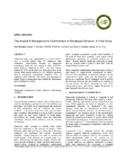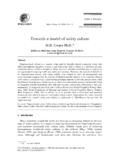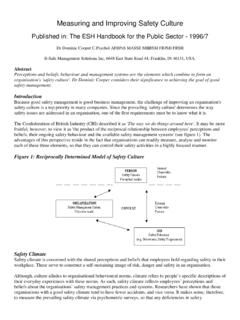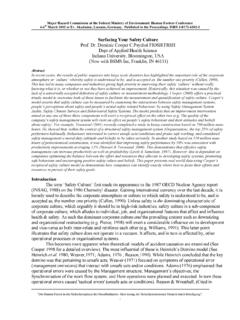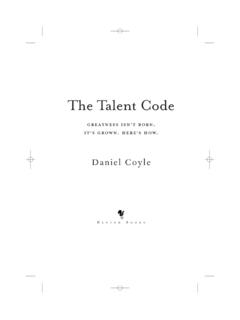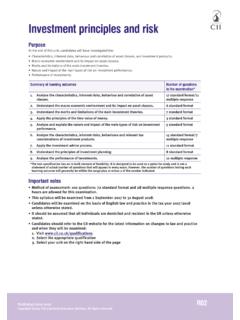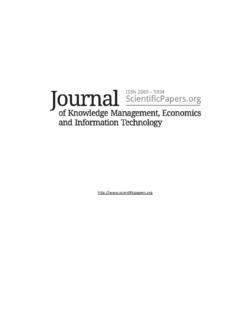Transcription of Navigating the safety culture construct: a review of …
1 2016 Dr. Dominic Cooper CFIOSH 7/22/2016 Navigating the safety culture construct : A review of the EvidenceNavigating The safety culture construct : A review of the Evidence Cooper 2016 First published July 2016 ISBN 978-0-9842039-2-5. All rights reserved. Dr. M. Dominic Cooper asserts his moral right to be identified as the author of this publication. Reproduction of this publication for educational or other non-commercial purposes is authorised without prior written permission from the copyright holder provided the source is fully acknowledged.
2 Reproduction of this publication, or parts of it, for resale or other commercial purposes is expressly prohibited without the prior written permission of the author who retains and reserves all world-wide rights. Disclaimer In no event shall the author or B-Safe Management Solutions Inc. ( BSMS ) be liable for damages or losses of any kind, however arising, from the use of, or reliance on this document. The responsibility for the interpretation and use of this publication lies with the user (who should not assume that it is error-free or that it will be suitable for the user's purpose) without BSMS assuming responsibility for errors or omissions in this publication or in other source materials which are referenced by this publication.
3 The mention of specific entities, individuals, source materials, trade names or commercial processes in this publication does not constitute endorsement by the author or BSMS. This disclaimer shall be construed in accordance with the laws of the State of Indiana, USA. Acknowledgements The author gratefully acknowledges the organising committee (FonSCI/ICSI) of the International Conference on safety culture (Safetygranada2016) whose invitation to speak at the conference in June 2016, prompted this work. Similarly, although they may not have agreed with all of the interpretations/conclusions, the author wishes to thank and acknowledge those academic and practitioner reviewers for their invaluable comments and insights on earlier drafts of this work.
4 Any errors, interpretations, and conclusions are entirely the author s responsibility alone. The author is grateful to BSMS Inc. for publishing this work, who conducted the works in his capacity as an independent scientific researcher. About the Author A Chartered Fellow of IOSH, a Chartered Psychologist, a professional member of the ASSE, and an IOSH award-winning author, Dominic Cooper, , pioneered the use of Behavioural safety in the UK on behalf of the British Health & safety Executive (HSE) while studying his at UMIST in 1989. A prior professor of safety , and a past professor of industrial/organisational psychology at Indiana University, Bloomington, he has authored many books, articles and scientific research papers.
5 Primarily these have been on safety culture , behaviour-based safety and safety leadership, but also include motivation and personnel selection. Navigating The safety culture construct : A review of the Evidence Cooper 2016 i EXECUTIVE SUMMARY Objective This review has considered the extant literature surrounding safety culture published since 1986. The focus of the review was to ascertain the utility of the safety culture construct in preventing process safety incidents and serious injuries and fatalities (SIFs). The purpose of this report is to summarise the main findings to provide an evidence-based guide in the development of robust safety Cultures in industry.
6 Theoretical Findings Findings show a plethora of definitions are causing confusion within both academe and industry. There is an urgent need for consensus on this issue, and a need for academics to stop re-inventing the wheel. Three influential models of safety culture were examined: Guldenmund/Schein (2000), Cooper (2000), and Reason (1998). The Guldenmund/Schein three-layered model focusing on visible artefacts, espoused values, and basic assumptions is not supported by the evidence. Cooper s reciprocal model of safety culture encompassing psychological, behavioural and situational elements is supported by large scale studies, while Reason s model using inter-locking sub-cultures that lead to an informed culture (equivalent to a safety culture ) is also supported by evidence from safety management system research.
7 Using the International Atomic Energy Agency s (1991) original definition of safety culture as a framework to anchor the review shows: Consensus between academe and the results of public enquiries into disasters about the main safety culture characteristics. These should be the main targets to improve organisational safety cultures Psychological factors such as attitudes, values, and norms are rarely assessed correctly Common significant safety issues to avoid process safety disasters and SIFs are well known, and provide a tangible and robust focus for assessing the safety culture construct .
8 The above findings are used to provide a clear pathway for improving, assessing, and researching safety culture . Practical Findings The extant evidence was subjected to a survival of the fittest test to ascertain any relationships to actual safety outcomes ( incidents and injuries and actual safety behaviour). This shows: attitudinal and safety climate surveys exhibit non-existent to weak relationships to actual safety outcomes no published studies have assessed the relationships between Values or Norms and actual safety outcomes Situational and behavioural factors demonstrate strong and consistent relationships with actual safety outcomes.
9 It is concluded that the sole use of psychological factors ( attitudinal or safety climate surveys) as a proxy for safety culture is fatally flawed. The research evidence shows organisations should concentrate 80 percent or more of their safety culture improvement efforts on situational ( safety management systems) and behavioural ( managerial safety related behaviours) factors to prevent process safety and SIF incidents. Navigating The safety culture construct : A review of the Evidence Cooper 2016 ii Contents EXECUTIVE SUMMARY.
10 I Introduction .. 1 The Starting Point .. 2 The safety culture Swamp .. 3 The safety culture Peaks .. 5 The safety culture Forest .. 10 The safety culture Valley of Death .. 17 The Long and Winding safety culture Road .. 21 Discussion .. 23 References .. 26 Navigating The safety culture construct : A review of the Evidence Cooper 2016 1 Introduction The term safety culture is a social construct that is used by industry and regulators to describe the way that safety is managed in organisations to avoid catastrophes and personal injuries.
